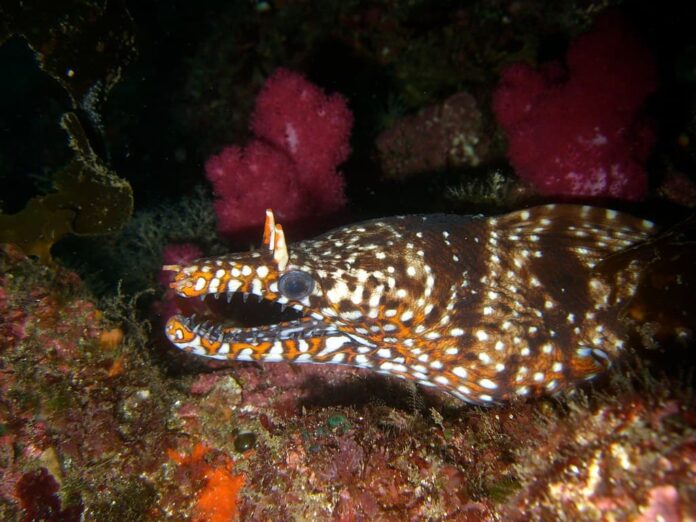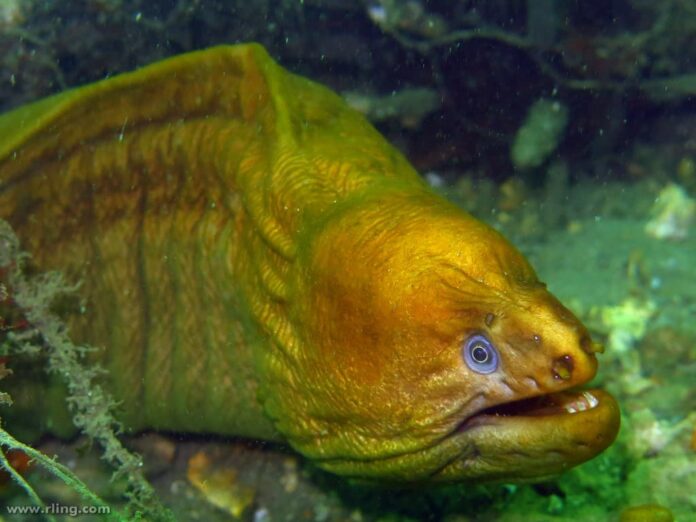Moray eels are the scary-looking marine creatures with large jaws that many of us know about. Among 200 moray eel species, only several are bright when it comes to colors and patterns. As for today, I am going to introduce you to 10 stunning moral eel species that might catch your eye. Feel free to check them out and let me know your most favorite ones.
1Chain Moray

Scientific Name: Echidna Catenala
On average, a chain moray is around 40 centimeters long but there are some that can grow up to 165 centimeters. This marine eel has an elongated body with a rounded snout that gives a very scary appearance. More than that, the dorsal, anal, and tail fins are combined together into a single long fin while the entire body is scaleless. A chain moray is dark brown to black in color with interconnecting yellow chain-like lines; hence the name. It has pointy blunt teeth that work wonders when it comes to crushing the shells of large crabs.
Chain morays are residents of the Western Atlantic Ocean where they live in reefs, rocky shores, and shallow parts. They inhabit crevices and holes of coral reefs, rocky coastlines, and sandy areas. Just like other moray eel species, this one is also solitary and they dwell alone. As nocturnal predators, they mostly hunt at night by waiting for prey at a close distance from their holes. Their most favorite food is crabs but these eels also feed on octopi, shrimps, other crustaceans, and small fishes. They swallow small crabs whole but they can tear apart the larger ones by tugging, rotating, knotting, and thrashing movements.
2Dragon Moray Eel

Scientific Name: Enchelycore Pardalis
Such a powerful name, the dragon moray also goes by other names as leopard moray eel or tiger moray eel. Why the name? The colorations and the patterns on its 92 centimeters body say it all. Dragon morays are one of the most striking and vibrant moray eel species with an orange-brown body and bright patterns. They have spots and streaks of black and white all over its body from head to tail. Dragon morays are scaleless but they have toxins in their skin that can be fatal if not prepared correctly. The most distinctive feature of this moray is the nostril tube set in front of its eyes that look like horns; hence the name.
This moray eel species has a wide range throughout the Indo-Pacific Oceans, inhabiting coral and rocky reefs. They are both elusive and nocturnal so coming across one is very rare. Also, they have poor eyesight so they rely on their excellent sense of smell for hunting. A dragon moray only comes out at night to hunt, and its favorite meals are fish and small cephalopods. Thanks to their powerful jaws and razor-sharp teeth, grasping and holding onto prey give them zero chances of escaping. However, there is one specific animal whose life dragon morays won’t take; the cleaner shrimp. These morays will pursue cleaner shrimps for dental care, and the shrimps will get to live in return.
3Fangtooth Moray

Scientific Name: Enchelycore Anatina
Despite the resemblance to the leopard, the fangtooth morays have the same nickname as dragon morays, tiger moray. However, it also has its own unique nickname which is the bird-eye conger. This moray eel species has a bright yellow head and a dark brown body with pale spots all over. The most fascinating feature about the fangtooth moray is the mouth that is filled with long glasslike teeth that look absolutely terrifying. How long are those teeth though? Just around 2 centimeters long, enough to put deep puncture holes with a simple bite. Plus with the long body that can reach as long as 120 centimeters, it is a fearsome creature.
Fangtooth morays live in warmer parts of the Eastern Atlantic Ocean, inhabiting coral reefs and rocky bottoms rich in crevices. This nocturnal eel feeds on benthic fish, cephalopods, crustaceans, and even dead animals using its extremely sharp teeth. They also have the habit of opening and closing their mouths to move water through their gills for respiration. This habit and those sharp teeth attract a lot of attention from divers and photographers. Though looking like a threatening behavior, it is not. Moray eels are not aggressive and they are shy creatures but they are not afraid to bite if they feel threatened.
4Green Moray

Scientific Name: Gymnothorax Funebris
Probably the least vibrant moray eel species, the green moray still has many fascinating things to know about. This eel is the largest moray of the tropical Atlantic, reaching a length of 2.5 meters. While looking green in photos, they actually have brownish or gray skin. However, the mixture with a layer of yellow mucus that the eel excretes, the green hue appears. And as you can see, this moray has no markings or patterns on its body at all. It is quite easy to recognize them if you see one.
As for this moray, its population occurs in the Western Atlantic Ocean where they live in coral reefs, mangroves, and rocky shorelines. They also live in areas over muddy and sandy bottoms, harbors, seagrasses, and tidal creeks. Green morays use their strong sense of smell to locate their favorite prey such as cephalopods, crabs, crustaceans, and fish. They will eat any fish that their sharp teeth in both jaws can tear apart.
While some moray eel species fall prey to human consumption, this one is rather safe because it is poisonous. Green moray can cause ciguatera fish poisoning with symptoms such as diarrhea, dizziness, numbness, sensitivity to hot and cold, vomiting, and more. Symptoms may take a few days to appear and can last for just a few days up to a few weeks or months.
5Honeycomb Moray

Scientific Name: Gymnothorax Favagineus
The honeycomb moray aka the leopard moray is one of the vibrant moray eel species in the marine water. It is another large moray eel species that can reach a maximum length of 3 meters long. A honeycomb moray has a white to yellowish body with many nonidentical black spots that resemble leopard rosettes. This complex pattern does not only make it visually appealing but also provides it with excellent camouflage within its habitats.
Honeycomb morays are widespread throughout the Indo-West Pacific region, inhabiting the outer slopes of coral reefs. It is very common for them to inhabit seagrass beds in island lagoons and shallow bays. The unique thing about this moray is that it likes living in crevices on a reef with clear water. Just like other morays out there, this one also mainly feeds on cephalopods and small fish its jaws can grasp.
It is absolutely wild for the honeycomb morays to be popular in the aquariums, some humans do have a strange taste. A honeycomb moray can be very aggressive, and they belong to the wild not in captivity. The thing is that honeycomb morays are very easy to train, and they are also easy to feed. Not to mention their striking appearance, many hobbyists have every reason to keep them in their aquariums.
6Jewel Moray

Scientific Name: Muraena Lentiginosa
Such a precious name, and the beauty of this moray is the main reason why. A jewel moray is around 61 centimeters long, and its brown body is adorned with dark-edged white-gold spots all over. These little spots look like sparkling jewels on the eel’s body; hence the name. But don’t let the pretty look trick you because jewel moray still possessed razor-sharp teeth. This moray eel species is endemic to the Eastern Pacific all the way to the tropical reefs of South America. Jewel morays hang out in shallow water sometimes but they usually remain under cover in rocky crevices during the day. When the night comes, they emerge to feed on crustaceans and fishes, and even other eels sometimes. Jewel morays are extremely aggressive so it is advisable to admire their beauty from a safe distance.
7Undulated Moray

Scientific Name: Gymnothorax Undulatus
Similar to many moray eel species out there, this one also grows to a length of 1.5 meters. What I really like about morays is that it is very easy to tell each species apart by their appearance. An undulated moray has a yellow head and light to medium brown body covered with brown spots. There are also irregular brown blotches with white borders that look similar to a chain link which is a distinctive feature of their look.
The range of this moray is in East Africa, the Indo-Pacific, and the Pacific. They live in coral reefs, rocky reefs, and lagoons with caves and crevices. As the sun goes down, an undulated moray comes out to hunt for cephalopods, crustaceans, and small fish. And while most morays are shy, this one has the reputation for biting more often than the others. The wounds are prone to infection due to the bacteria living in the eel’s mouth. At the same time, their razor-sharp teeth can cause damage to the muscle, nerve, or tendon if the bite is serious. So if you come across a moray with a yellow head while diving, make sure to maintain your distance.
8Yellowmouth Moray

Scientific Name: Gymnothorax Nudivomer
The yellowmouth moray or the starry moray is one of the largest moray eel species in the world. Some can grow up to 180 centimeters, and it has a very fascinating appearance. A yellowmouth moray’s body has a brown background with small white spots circled with a darker brown outline. These dots resemble stars on the sky; hence the nickname starry moray. And just like the name suggests, the inside of its mouth is bright yellow in color. This moray is also widespread throughout the Indo-Pacific area, living on the outer slopes of coral reefs.
9Y-Patterned Moray Eel

Scientific Name: Gymnothorax Berndti
It is not a common thing to see a moray with this color, and that’s what makes it unique. A y-patterned moray’s pale tan body can grow up to 100 centimeters long. It has a fine dark brown lines and reticulations with 29 to 35 irregular narrow dark brownish bars and wider dark bars. The y-patterned moray is a deep-water moray eel species that lives in coral reefs in the Pacific and Western Indian Oceans. It can live at depths of 300 meters in deep reefs among rocky and spongy areas so divers don’t see them much.
10Zebra Moray

Scientific Name: Gymnomuraena Zebra
What’s more vibrant than a zebra pattern, right? A zebra moray has white bands on its dark brown body that can reach a maximum of 150 centimeters. There are white rings in some specimens but there are also lighter ones with faint reddish rings instead. Another unique thing about them is that they have rounded and almost pebble-shaped teeth instead of fang-like teeth. However, those teeth still can inflict pain so don’t get close to them.
Zebra morays have a wide range throughout the Indo-Pacific area from the eastern coast of Africa to the western coast of the Americas. And not different from other moray eel species out there, this one also inhabits coral or rocky reefs. When hunting, it feeds on clams, crabs, mollusks, sea urchins, shrimps, and other hard-shelled prey. However, zebra morays are rather docile so they are also quite popular in larger marine aquariums.
Related Post: Most Dangerous Eel Species




